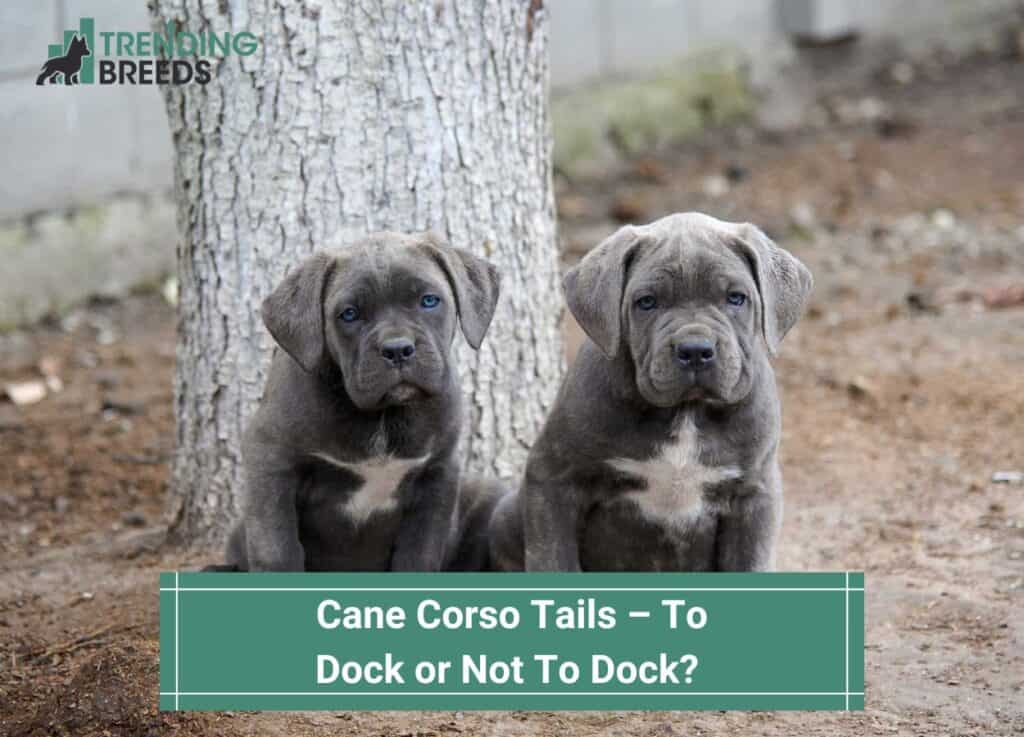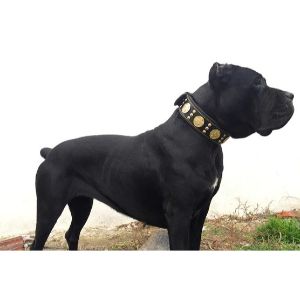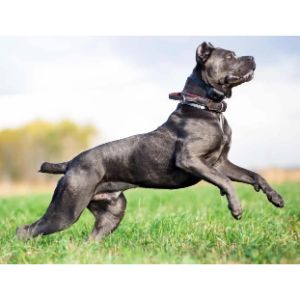
For a long time, tail docking was considered the standard for many breeds. Shelters, dog breeders, and veterinarians often performed this procedure without a second thought because of how widespread it was.
However, in recent years, there have been more questions about the practice and whether or not individuals should decide to dock their dog’s tails.
There are several reasons that each side of the argument holds, so this guide will examine those reasons as objectively as possible.
Read on to discover why people dock Cane Corso tails and why some decide not to.
Other articles you would like: Cane Corso Puppy Costs and Belgian Malinois Cane Corso Mix Guide
Table of Contents
What Is Tail Docking?

Tail docking is a surgical practice for dogs that removes a part of the dog’s tail. There are two methods of tail docking, and both are typically done when the dog is a puppy.
The first method is to tie a surgical thread around the desired tail length and wait for the excess tail to fall off from lack of blood. The second method is to separate the tail with a scalpel or surgical scissors.
The breed standard for many dogs lists a docked tail as necessary, suitable, or preferred. Breed standards are the ideal metrics that a breed should aspire to or meet, often used to judge competitions.
Breeds that include docked tails in the standard include the Cane Corso, Rottweiler, Bandog, Doberman Pinscher, and Boerboel.
The process of tail docking and the controversy surrounding it is similar to declawing with cats.
Reasons To Dock a Cane Corso Tail

There are three main reasons a Cane Corso’s tail is docked: after an injury, to prevent damage, or for appearance.
After Injury
Some dogs have to have their tails docked after injuring them. One of the often-cited reasons for these injuries is Happy Tail Syndrome, a severe issue despite its name. Dogs are known to wag their tails, but some wag too hard.
Dogs that frequently wag their tails very hard and wag their tails against solid objects may injure their tails, which is symbolic of Happy Tail Syndrome. These dogs whack their tails against hard things like walls, chairs, and appliances.
While hitting their tail against a wall every so often will not likely injure them, repeatedly hitting their tails causes serious injury to dogs. The skin of the tail often splits and may bleed freely. In other cases, the bones of the tail may fracture.
Tail docking is generally accepted in the case of Happy Tail Syndrome. In some cases, the tail is too damaged to repair, and in other cases, docking is necessary because the dog will quickly injure it again the same way after healing.
In cases other than Happy Tail Syndrome, docking/amputation is deemed necessary by veterinarians due to severe injury, fracturing, or partial accidental amputation.
To Prevent Injury
Some argue that tail docking is necessary to prevent injury for working or breed-prone reasons. For working dogs, many people say that long tails are prone to issues and possible infections.
For example, hunting dogs that frequently make their way through crowded forests may have sharp leaves or burrs attach themselves to the tail.
The second argument for tail docking to prevent injury deals with breed-prone issues.
The most prevalent of these is Happy Tail Syndrome, as discussed above. Any dog can suffer from Happy Tail Syndrome, but breeds with long, sturdy tails are at a slightly higher risk.
Dogs with long, sturdy tails that are at a higher risk for tail injury, including Happy Tail Syndrome, include:
- American Bulldog
- Boxer
- Dalmation
- Doberman
- German Shepherd
- Golden Retriever
- Greyhound
- Great Dane
- Pit Bull Terrier
- Pointers
The argument for docking for these breeds states that by docking the tail, you can prevent potential injury that involves the tail.
Some people argue that tail docking prevents future infection, but this claim was debunked, as tail docking is linked to infections rather than preventing them.
Appearance
Docking dog’s tails for cosmetic purposes has long been a standard held up by dog associations, dog breeders, and judging panels.
Tail docking is included in the breed standard for the Cane Corso. Because of this, many people consider docking their Cane Corso’s tail to fit the breed standard.
It is widely agreed upon by veterinarians, including the American Veterinary Medical Association, that tail docking only for cosmetic purposes is not a necessary practice. It is detrimental to the dogs’ health when the procedure is performed.
The current breed standard set by the American Kennel Club for the Cane Corso breed includes guidelines for both docked and natural tails.
Unlike other breeds, natural tails for Cane Corsos are not given lower points than the “ideal” docked tail that was the original breed standard.
Reasons To Not Dock a Cane Corso Tail

The primary reasons to not dock a Cane Corso tail are issues of legality, ethical concerns, the communication factor of a dog tail, and appearance.
Legality
One of the most critical factors in whether you dock a Cane Corso’s tail is whether the practice is legal in your area. In many regions of the world, tail docking has been outlawed.
In the United States, the practice remains unregulated, though pushes for states to ban the practice are gaining traction.
In the United Kingdom, tail docking is illegal, and owners may not show dogs with tails docked after 2007 (when it became unlawful) in competition. Docking a dog’s tail for cosmetic purposes is a criminal act with a hefty fine attached.
In Australia, Austria, Belgium, Chile, Columbia, Croatia, Cyprus, Estonia, Finland, Greece, Hungary, Iceland, Ireland, Italy, Latvia, Lithuania, Luxembourg, Netherlands, Norway, Poland, Scotland, Slovakia, Slovenia, Sweden, Switzerland, Turkey, and Virgin British Islands, the practice of tail docking is banned entirely.
In Bosnia and Herzegovina, Brazil, Denmark, Germany, Israel, Serbia, South Africa, and Wales, the practice is banned with some exceptions.
Ethics
Many people argue that tail docking is unethical. The procedure is generally performed without anesthesia, and veterinarians recognize that the procedure is painful, no matter the dog’s age.
The argument for docking typically states that because dogs are subject to tail docking between three and five days old, the puppies do not remember and can’t process the pain.
Advocates against tail docking, including veterinarians, state that despite their age, puppies can process the pain of tail docking and may remember the procedure.
Dog owners hate to imagine their pups in pain, and we often go to great lengths to avoid this. Recently, many owners have become advocates against docking as veterinarians have written and shown research that the practice is a painful experience for the dog.
In addition to the pain experienced during the procedure, many veterinarians have discussed the potential issues and complications that tail docking could lead to. A tail dock neuroma is a severe issue that may develop from tail docking.
Communication
Dogs use their tails to communicate, so many people view docking a dog’s tail as taking their ability to share away.
This also applies to how dogs communicate with each other. Dogs with docked tails may be less confident or submissive in group situations with other dogs.
Dogs with docked tails may not be able to communicate to other dogs that they are uncomfortable or welcoming.
Relaxing the tail is a sign of welcoming, but many dogs with docked tails have issues controlling their tail direction precisely because their tail is shortened.
Dogs also communicate with humans using their tails. Most people recognize that dogs wag their tails when they’re happy, but dogs can display a range of emotions using just their tails.
The biggest issue facing dogs with docked tails and communication is that a dog may not be able to communicate discomfort or fear. If a dog becomes uncomfortable or fearful, those emotions can quickly turn to aggression in wary situations.
The issue of fear and discomfort turning aggressive is a particular issue with the Cane Corso breed. These dogs are typically peaceful and highly affectionate, but they are also fiercely loyal.
The Cane Corso is the primary guard dog breed, and this dog may resort to aggression if it cannot correctly communicate its fear, anxiety, or discomfort.
Appearance
Like Mastiffs and Pitbulls, Cane Corsos are often mistaken as aggressive dogs. Dogs within these breeds with cropped ears and docked tails are generally seen as prone to aggression.
Conversely, the Cane Corso with uncropped ears and tail is often seen as a less aggressive dog. The stereotype is unfair, but many recognize that leaving their dog’s natural tail and ears can avoid possible issues with people who expect aggression.
Many advocates against tail docking have encouraged people to embrace the look of a Cane Corso with ears and tail, neither cropped nor docked, because embracing this look will destigmatize the breeds.
Should You Dock Your Cane Corso’s Tail?

Whether or not you decide to dock your Cane Corso’s tail is up to you, but there are a few critical factors that will likely influence your decision.
Docking a dog’s tail for cosmetic purposes is considered unnecessary and potentially harmful. In addition, the breed standard for the Cane Corso no longer requires a docked tail, so there is no competition to docking a Cane Corso’s tail.
In medical situations, docking a Cane Corso’s tail may be necessary. The breed has slightly long and sturdy tails, so they may find themselves suffering from Happy Tail Syndrome.
If you notice any splitting of the skin, bleeding, or visible pain regarding your Cane Corso’s tail, consult your veterinarian and ask if tail docking/amputation is a necessary procedure.
Tail docking to prevent a tail injury, such as Happy Tail Syndrome, is generally considered unnecessary. This reasoning is because the rate at which dogs suffer from tail injuries and Happy Tail Syndrome is not high enough to justify the procedure.
Tail docking after a procedure is accepted, but docking before an injury is not recommended.
For people in the United States, tail docking is a personal decision as the practice is unregulated.
However, around the world, the practice has been banned and is restricted or illegal in many areas. For people living in the United Kingdom, tail docking is a criminal act for a veterinarian to perform.
Conclusion For “Cane Corso Tails – To Dock or Not To Dock?”

Whether or not you dock your Cane Corso’s tail is a personal decision, but many factors may affect that decision. This guide covers why people decide to either dock or not dock their dog’s tails.
We hope this guide has been helpful as you make these decisions for your dog’s future!
You will also like:
- Cane Corso In The Snow – Can They Handle Cold Weather?
- Have A Scaredy Cane Corso? Help Your Shy (Timid) Dog
- Do Cane Corsos Drool A Lot?
For more information about the Cane Corso Breed, check out the video below:




